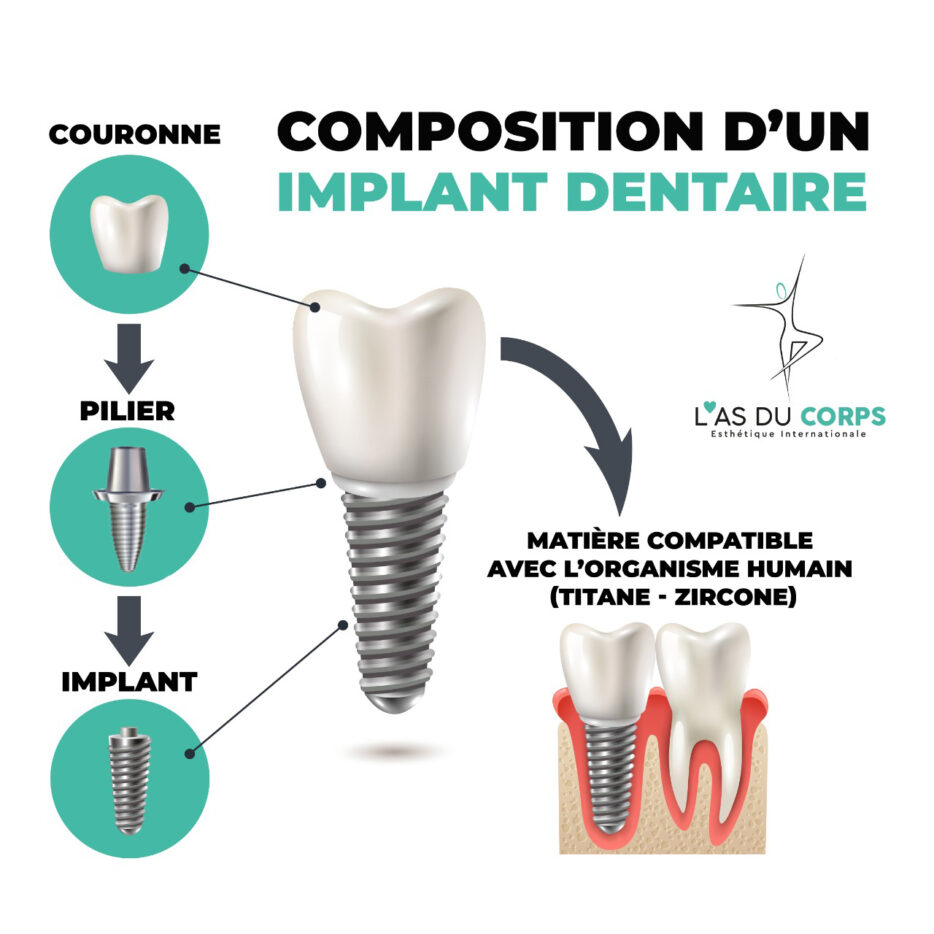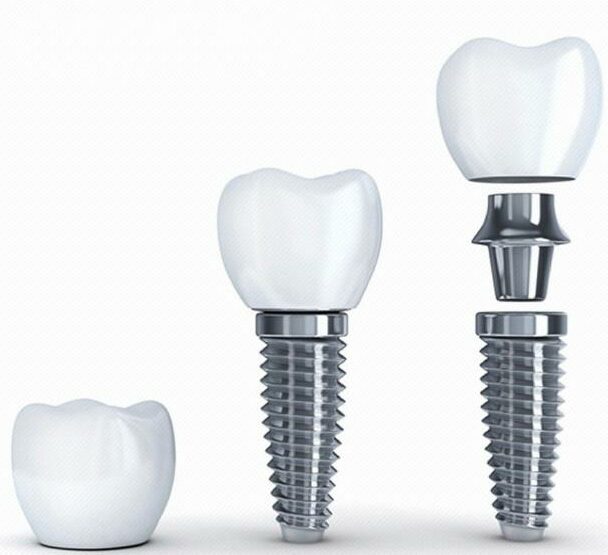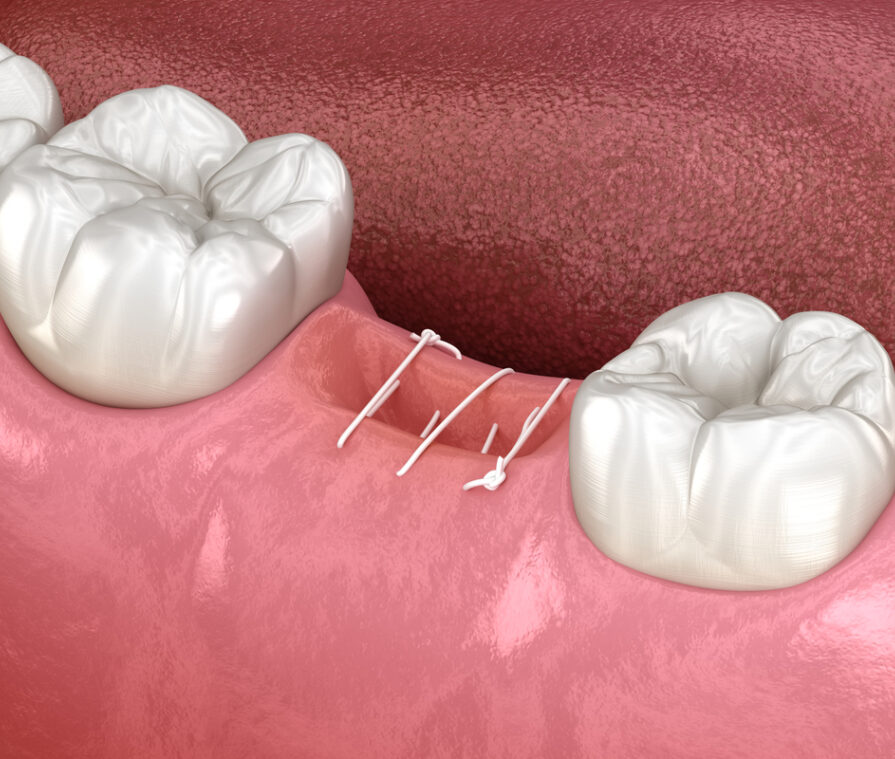An Artificial Root
What Is an Implant?
A dental implant is one of the solutions to replace a missing tooth or a tooth that is compromised by trauma, infection, or periodontal disease. It is an artificial root most often made of biocompatible titanium placed in the maxillary bone serving as a base for fixing single crowns, and bridges on several teeth or as an anchor for complete dental prostheses.
The dental implant is a metal rod made of titanium and comes in different shapes and sizes to adapt to the needs and pathology of each patient. They can measure between 10 to 15 mm long. This great diversity guarantees the perfect integration of the implant to obtain the best resistance and longevity of the implant. To avoid the risk of rejection, the implants are made of materials compatible with the human body such as zircone or titanium. They will enable the bone cells to naturally weld there. Titanium is mechanically very resistant and well suited to the pressure caused by chewing.

The advantages of an implant
Our natural teeth help keep our bones strong and healthy. The forces we generate when we chew are transmitted to the bone by the roots of our teeth, stimulating the maintenance of bone density. After the loss of a tooth, the bone in the empty space does not receive this stimulation and may begin to slowly resorb. Over time, this bone resorption can change the shape of the face. Visit Dental implants transmit the forces of mastication to the jawbone, helping to maintain a healthy jaw and thus preserve the structure of the face and facial support (lip).

More than just a dental restoration, an implant allows you to regain a better quality of life, both functionally and socially. Implants enable people to bite, chew and speak without depreciation or embarrassment when it comes to interacting with others, whether in a professional, friendly or family discussion.
They also minimize any bone loss in the area of the jaw where they are placed, helping to preserve facial support (lip) and thus your appearance, and maintain the structure of the jawbone.
The implant selected by L'As du corps
We work with several world-renowned brands including the Straumann, a guarantor of high-end Swiss quality. Straumann is positioned as a world leader in implantology by offering state-of-the-art innovations, it has today earned the full confidence of the dental sector thanks to the reliability, stability, and resistance of its materials.
The latest prosthetic and implant solutions offer unparalleled longevity. They are more stable, more comfortable, and more functional than conventional prostheses.
The lifespan of an implant exceeds 25 years, but it depends on the success of its installation, the health of your gums as well as your oral and dental hygiene.


Healing
After placing the implant, it is necessary to wait for the jawbone to heal. This is the osseointegration phase, which can last from 3 to 6 months, depending on the case. It allows the bone to reform, and attach to the dental implant more solidly and durably. The healing period can last several weeks before the implant is completely fixed to the bone of your jaw, it is important to follow the post-operative instructions to optimize this healing and avoid failure.
During this healing phase, the surgeon can offer the patient a temporary crown to fill the gap and preserve the aesthetic appeal of the smile.
To place an implant, it is sometimes necessary to do a bone graft to have the right thickness of bone.
Micro-Surgery SOMETIMES Necessary: Bone Grafting and Sinus Augmentation
When you are missing a tooth, stopping bone stimulation creates resorption. The thickness of the jawbone becomes insufficient to receive a dental implant. A bone graft then becomes necessary to place one or more dental implants to ensure its solidity. To be fixed, the implant needs a minimum bone thickness of 6 millimeters.
Sometimes the maxillary sinuses go down so low that it is impossible to perform an implant placement. Therefore, it is necessary to correct the bone height and width. The dental surgeon then proceeds to the sinus lift and then to the bone graft to fill the sinuses.
The bone graft can be taken from the patient himself (autogenous graft), from another person of the same species via the bank of bone (allogeneic graft), on another species, generally bovine (xenogenic graft), or from synthetic material (alloplastic graft).
These procedures are painless and are performed under local anaesthesia for greater comfort.

The Stay
It will generally take 3 days on-site in Istanbul to place your implant(s). One and a single day is dedicated to possible surgeries and implant placement. However, if a complete extraction of the teeth is considered, the surgeon can suggest a temporary prosthesis, the making of which will require a few additional days. The same is true if a smile tooth needs to be pulled out. A medical coordinator will give you all the details in this case.
So don't wait any longer
to be confident again
and offer yourself the comfort of yesteryear!

